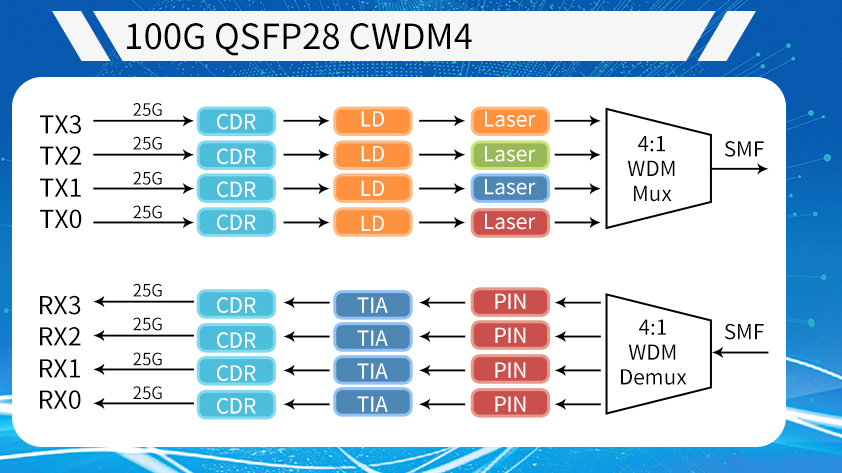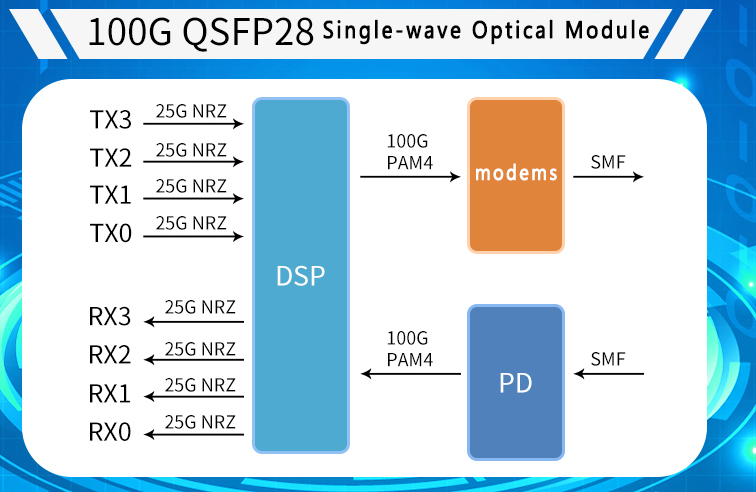

 Knowledge Base +
Knowledge Base +  2023.12.12
2023.12.12In recent years, with the rapid development of data centers and cloud computing, the demand for high-speed network equipment is also increasing. 100G Ethernet has become the mainstream standard for high-speed networks, and in 100G Ethernet, both single-wave optical modules and traditional optical modules are widely used. However, they have obvious differences in some aspects.
I. Differences between 100G single-wave optical modules and traditional 100G optical modules
Traditional 100G Optical Module
Traditional 100G optical modules use multi-wavelength technology, which usually requires four wavelengths to transmit 100Gbps data. This requires more components, including multiple lasers, modulators, multiplexers, and demultiplexers, which increases cost and power consumption. In addition, the port density and bandwidth density of traditional optical modules are relatively low.

100G Single-Wave Optical Module
Single-wavelength optical module is a new type of high-speed transmission module, which adopts single-wavelength technology and is capable of realizing up to 100Gbps transmission rate under a single wavelength. This means that single-wave optical modules can realize simpler optical design, reducing the number of components and complexity, thus reducing cost and power consumption (the cost of optical components accounts for about 60% of the cost of the entire optical module). In addition, single-wave optical modules have higher density, enabling higher port density and higher bandwidth density.

However, single-wave optical modules also have some disadvantages. First, because it uses single-wavelength technology, its transmission distance is limited and it cannot realize long-distance transmission like traditional optical modules. Second, because of the new technology used in single-wave optical modules, its cost is relatively high.
Second, 100G single-wave optical module classification
100G single-wave optical modules currently have four models: 100G QSFP28 DR, 100G QSFP28 FR, 100G QSFP28 LR and 100G QSFP28 ER. They all belong to the single-mode optical module, the working wavelength is 1310 nm. the following table shows the specific parameters:
C. Alternative or Supplementary Solutions for 100G Long Distance Transmission
100G single-wave optical module can be used as an alternative or complementary program for 100G long-distance transmission, mainly based on the following considerations:
1, 100G single-wave optical module is an important advancement in high-speed optical communication technology, with high speed, low power consumption, high reliability and other characteristics, can effectively meet the high-speed transmission needs of big data, cloud computing, high-speed networks and other fields.
2, compared with the traditional 100G long-distance transmission scheme, 100G single-wave optical module has higher bandwidth utilization and lower cost. The traditional 100G long-distance transmission scheme requires the use of complex optical devices and modulation technology, high cost, and relatively low bandwidth utilization.
Fourth, 100G single-wave optical modules help the continuous development of optical communication technology
100G single-wave optical modules are widely used in data centers, cloud computing, high-speed networks and other fields, providing an effective solution to meet the high-speed transmission needs of these applications. 100G single-wave optical modules use single-channel 100G PAM4 technology, and in the process, many key technologies have been further researched and developed to provide the technical basis and experience accumulation for the realization of 400G and other higher-speed optical communication technologies. 100G single-wave optical modules use single-channel 100G PAM4 technology. The 100G single-wave optical module provides assistance for 400G development in terms of technology evolution, market demand and technology accumulation, and promotes the continuous development and upgrade of optical communication technology.
Subscribe to the newsletter
for all the latest updates.
2-5# Building, Tongfuyu Industrial Zone, Aiqun Road, Shiyan Street, Baoan District, Shenzhen. China
